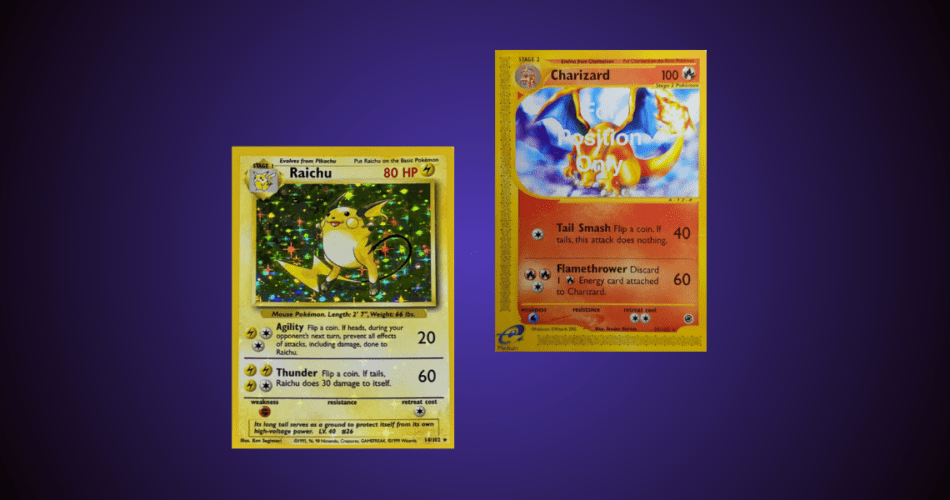Pokemon Error cards are big money and rare. The Pokémon TCG is a collectible card game with considerable consumer hype.
Based on the iconic Pokémon animated series that originally aired in 1997, the billions of cards printed over the years hold a great degree of nostalgic value to collectors who have watched the Pokémon adventure unfold from start to finish.
SHOP POKEMON ERROR CARDS ON EBAY
With an estimated volume of 52.9 billion cards produced worldwide by Creatures Inc., you’re bound to find a limited production size of cards with a slight defect or two.
Error cards offer a rare and unique representation of incorrect elements from the result of mistakes in the printing process or human faults, which can include things like:
- repeated ink misprints;
- missing or additional text/ink;
- more or less holographic than normal;
- square corners;
- mis cuts; as well as
- corrected and uncorrected design errors.
With error cards selling for a pretty penny on various online marketplaces like eBay and Amazon, there’s little wonder why they’re held in such high regard by collectors.
In this article, we’ll explore those happy little accidents within the Pokémon franchise, by revealing the cool imperfections on valuable error cards that are well worth adding to your Pokémon TCG collection.
#1. Prerelease Raichu Error Pokemon Card
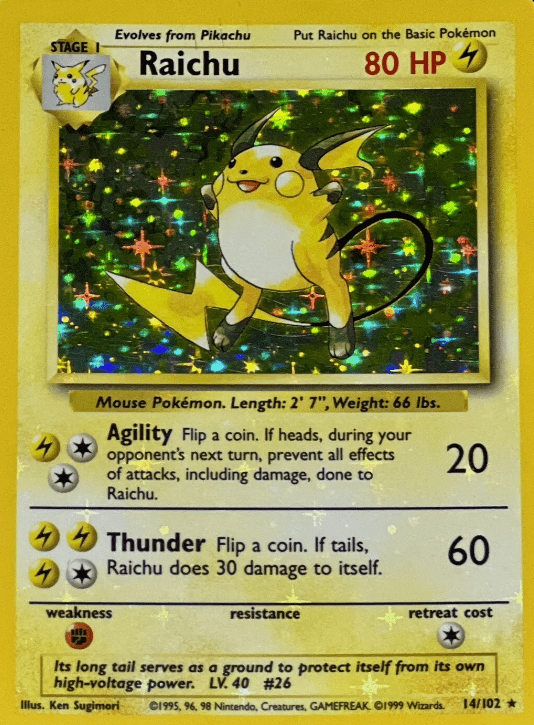
A pre-release card has a “PRERELEASE” or expansion logo stamp on it that promotes a new set of cards that are about to be unveiled. Usually, these cards are handed out at special events, as a way of building excitement for the next publishing sequence.
When a pre-release stamp is erroneously printed onto several existing base cards, you end up with a peculiar imperfection that draws considerable attention from long-standing Pokémon fans.
That’s pretty much what happened with the elusive “Prerelease Raichu” card, born under the aforementioned circumstance.
Word has it that during the print run of a Jungle Clefable pre-release card, the pre-release stamp was mistakenly inked on a certain number of base set Raichus. A limited number of these cards slipped through the production cracks and landed on the retail market.
Many people consider Prerelease Raichu cards to be the “holy grail” of error cards, particularly because of the mystery surrounding their existence.
The developers of Pokémon TCG haven’t officially gone on record to say that these cards exist. On the contrary, many people claim ownership of this error card, which you can find for sale on various online marketplaces.
Ultimately, whether the Prerelease Raichu cards sold today are real or fake is a question without an answer.
#2. Magic: The Gathering x Pokémon Error
The mistake here lies with the publishing company (i.e. Wizards of the Coast) that was handling the printing of cards from two separate franchises – Pokémon and Magic: The Gathering.
What happened is that a small set of Pokémon cards were printed with the wrong backing. Somewhere along the production line, Magic: The Gathering card stock was used to print a few Pokémon test cards.
This happened early on in the Pokémon series, which has had a positive knock-on effect on the overall value of this rare error card, which matches the price of a highly coveted Prerelease Raichu.
Many people have encountered the Blastoise cards possessing this production defect, although some photos online show Growlithe and Arcanine cards with the same flaw.
All four variations of the Blastoise cards have been officially certified as genuine, with each one containing subtle differences, such as the small lightning bolt next to Blastoise’s HP, and a different font for the text elements contained.
Considering all these unique factors, this error card becomes a scarce collector’s item that commands significant sums of money.
#3. Flipped Logo Movie Promo
Turning back the history books to when the first Pokémon movie aired in cinemas, special promo cards were given to anyone who bought a ticket to see the animated film.
These cards were based on popular Pokémon characters like Pikachu, Electabuzz, Mewtwo and Dragonite. Each promo card contained a signature gold-colored ‘Pokémon: The First Movie’ stamp printed in the top right corner of the artwork.
However, for reasons unknown, a few of these cards were flipped over during stamping, which resulted in the gold logo printed near the bottom left side of the card as opposed to the top right end.
Taking the example of a flipped-over Mewtwo promo card, you’ll see an upside-down Pokémon logo printed right beside the character’s Psyburn ability, which is a damage-inducing psychic-type blast inflicted on opposing Pokémon that leaves them unable to act and have their defense decreased for a short while.
While many people can lay a claim to owning a standard Pokémon movie promo card, only a select few possess the rare flipped stamp error card, which can fetch upwards of a couple hundred dollars on eBay.
#4. For Position Only Pokemon
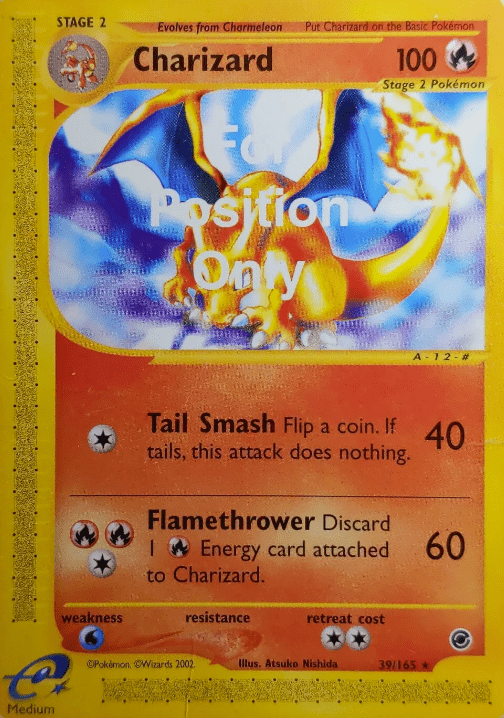
Mass-produced items like Pokémon TCG cards usually undergo an established testing process before being publicly sold.
Of course, these test runs are designed to ensure the perfect condition of the cards upon release for fans to enjoy.
As part of this procedure, some cards are distinctively marked in some way, shape, or form as not to be sold, so they don’t find their way onto a batch set for delivery to a wholesaler or retailer.
However, mistakes happen with certain cards ending up overlooked.
Over 100 “For Position Only” cards that were supposed to be destroyed upon completion of the testing process managed to find their way onto eBay and other Pokémon TCG collection sites.
These error cards bear a steep price tag due to the nature of their defect – a large piece of white instructional text overlaying an image of a particularly tenacious poison-type character called Arbok. The words “For Position Only” can be seen covering the face of the seven-footed serpentine Pokémon that resembles a cobra.
#5. Misaligned Holographic Cards
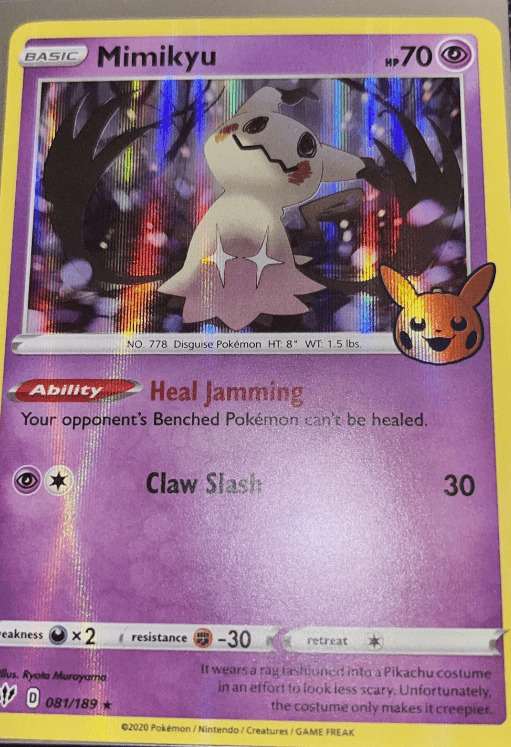
Next, we have the famous holographic Pokémon cards that have wowed many within the Pokémon TCG collectibles community.
You’ll notice a lot of misalignment quirks on the pre-E-Series Wizards of The Coast cards.
The catch with these cards is that the holographic foil used during printing is adjusted slightly upwards as the process happens, resulting in an aesthetically pleasing three-dimensional or cut-out effect that makes the cards look more holographic than they are supposed to be.
For example, the Fossil Articuno card features this error of alignment. You can see this in the image of the legendary bird Pokémon, as the upper ends of its wings appear duplicated. In addition, if you look carefully at the tail, you’ll see a darker outline above it, which adds to the holographic effect.
When it comes to the aspect of value, misaligned holographic cards don’t come cheap. They more or less match the prices of miscut cards on the market. A general rule of thumb is that the greater the misalignment of a holographic card, the higher the overall selling price.
#6. Holographic Bleed Cards
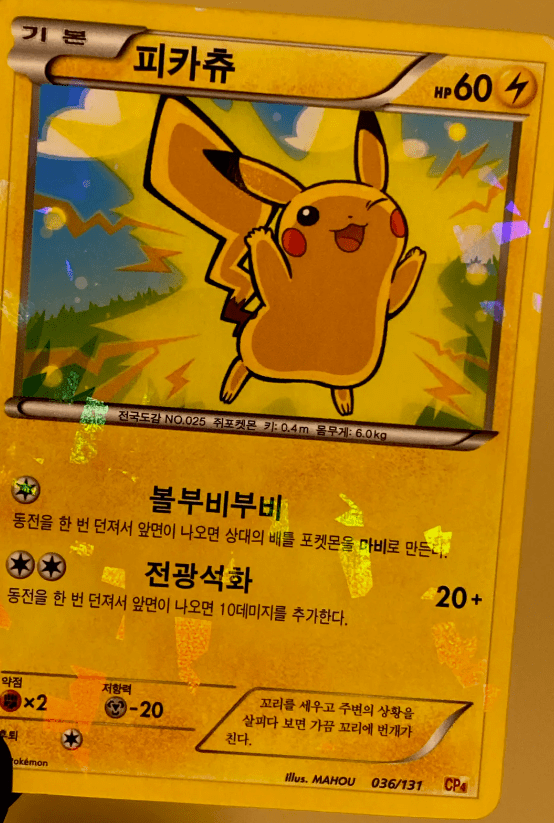
In a similar vein, there are more than a couple of holographic bleed cards that are worth picking up on today’s market of trading collectibles.
They belong to the overarching category of holographic error cards because the holographic effect present on them excessively “bleeds” onto the area of the card that isn’t supposed to be holographic.
Because of a printing error where the ink wasn’t applied thick enough while printing the card, the faint foil pattern is seen through other areas of the card besides the picture, where it shouldn’t be present.
Here’s a good quote from Sleeve No Card Behind on the holographic bleed definition:
“Holo bleed is when the foil treatment shows through the white opaque layer of the card, creating a slight holofoil effect where there shouldn’t be one.”
You’ll most likely find this sort of error on the base set Blastoise cards where the holographic foil shines through the printed ink layer in places where it shouldn’t, like on the sections describing the character’s Water Log and Hydro Pump abilities. Such cards may also have the holographic treatment extend over the entire card face.
As with any other error, the extent of the holographic fault determines the overall worth of the card in question. Holographic bleed cards are not usually a huge value add to most cards, but some like the ones featuring Charizard or Pikachu characters can see a significant bump in value.
#7. Extended Copyright
Pokémon TCG cards include several text-based errors that someone with a keen eye can spot and make a tidy sum of money on.
Usually, these text-based errors are limited to dropped words or minor grammatical mistakes, but once in a while, a hidden gem of extended copyright comes to the fore.
Pokémon TCG publisher Wizards of the Coast occasionally makes the mistake of printing out copyright notices that include an end date so far into the future that one questions the publisher’s power to retain the card as their intellectual property for such a long time.
For example, the Dark Abok misprint has a copyright date starting in 1999 and going all the way to the year 23000! Unfortunately, this particular card won’t sell for big bucks because the extended copyright error is present on the majority of Dark Abok cards, including the unlimited versions.
Nonetheless, any card with an unintended copyright typo located in the footer is a fantastic addition to a collection; one that you can proudly brag about to your friends.
#8. Ink Stains Pokemon
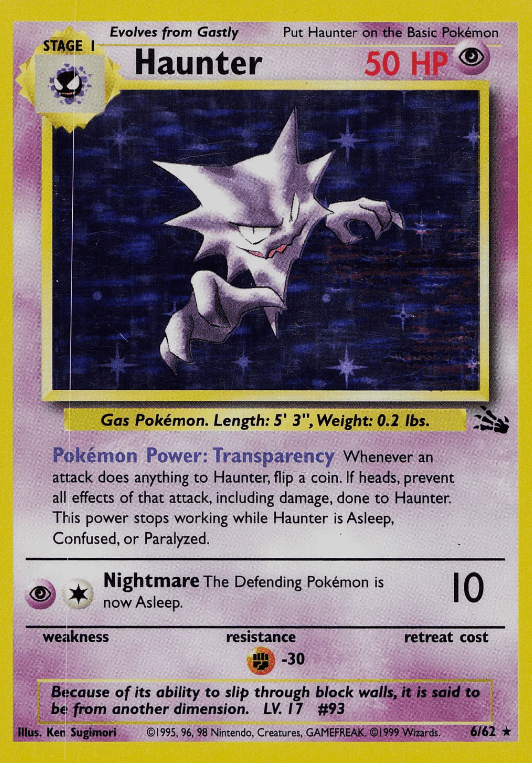
Have you ever experienced the pain of printing a physical paper document and having the ink uncharacteristically smudge itself over a part of the page? You’ll often curse yourself or get mildly frustrated by the thought of having to print out an extra page.
Well, the ink stain error on a Pokémon TCG card can evoke an identical feeling of annoyance, particularly if you’re unboxing a card set sealed from the time of purchase.
It’s distinct from the aforementioned printing errors in the sense that ink apportioned for a certain section of the card face gets smudged, resulting in a bad stain that distorts the card’s overall appearance.
One prominent example is the ink stain on a Haunter card, where the dark blue ink used to create a nice background for the image of this particular Pokémon character gets splotched towards the right side.
The result is a messy misprint that runs over and beyond the gold border-box, which can, fortunately, earn you a pretty penny if the rest of the card remains in good condition.
#9. Incorrect or Missing HPs
Concerning printing errors on cards, you’re more likely to encounter incorrect pieces of information like wrong dates on the copyright text or misspellings on Pokémon power descriptions.
This is quite understandable with the number of cards in annual production. Although you’d expect the developers and publishers to pay attention to every tiny detail, some things aren’t spotted until they’ve hit the retail shelves.
One of these errors is the Hit Points (HP) misprint, where a card will have incorrect or missing HPs labelled on it.
Hit points are a well-known stat that determines how much damage a Pokémon character can receive before fainting, so if you acquire a card without an HP figure in the top right corner, you could be on to a winner even if it renders your physical card game useless.
Perhaps the most prominent example of an HP printing gaffe is the Dark Persian card. A large number of these cards were printed without any HP indicators, making them a unique collector’s item worthy of a pickup at an affordable price.
#10. Image Errors
Shop Pokemon Image Error Cards

Finally, various image errors exist on a few Pokémon TCG cards, which can drive up their monetary value.
Image errors don’t necessarily fit the description of other categories because other than the image itself having a defect, there’s no processing error or quality control issue that is the cause.
Most of the time, you can think of an image error as someone using the wrong picture of a Pokémon character, or having an image of a Pokémon character containing an uncommon characteristic. These errors aren’t easy to distinguish, even under the keen eye of a hardcore Pokémon fan.
For instance, the Pikachu error card is a prized possession, as the image of Pikachu has red cheeks on it. As you know, Pikachu’s cheek color should be bright yellow.
This misprint is valuable because Pikachu is one of the front-facing characters who serve to embody the animated series, working alongside the long-time protagonist Ash Ketchum.
Long-term investment outlook of Pokémon error cards
The future of Pokémon TCG card values looks promising, with the animated series still airing on major television networks.
When you also consider the plethora of video games (e.g. Pokémon Scarlet and Violet) published by Nintendo and The Pokémon Company, you realize that the Pokémon media franchise has built up a continuous stream of consumer hype spanning different generations of fans.
The demand for Pokémon error cards is bound to be steady over the coming years, especially as the market for trading card collectibles continues to expand.
In the distant past, selling a Pokémon card for a hundred bucks on a platform like eBay would be unheard of, but today, the possibilities are extremely lucrative.
Some cards, like this PSA-graded Pikachu Red Cheeks card in pristine condition, sell for thousands of dollars, which is an encouraging snapshot of the current market.
